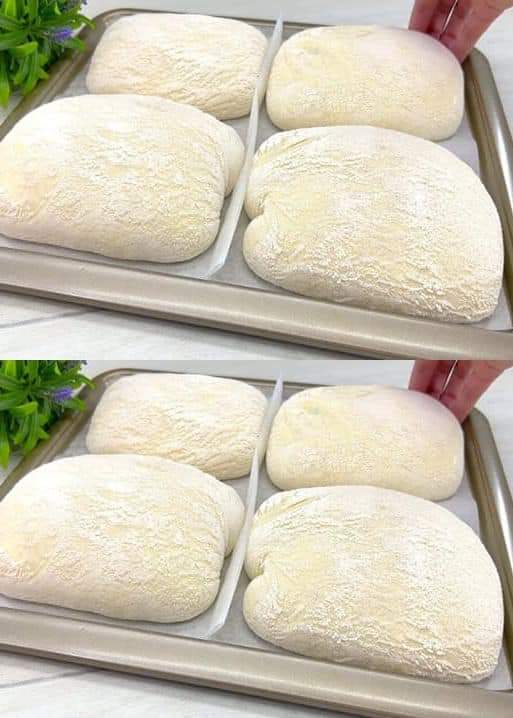Instructions
Begin by preparing the pre-ferment, or biga. In a mixing bowl, combine 100 grams (3/4 cup) of the flour, 100 milliliters (1/2 cup) of water, and a pinch of yeast. Mix until a shaggy dough forms, then cover the bowl with plastic wrap and let it ferment at room temperature for 12-16 hours.
The next day, in a large mixing bowl, combine the remaining flour, salt, yeast, and the biga. Gradually add the remaining water while stirring until a wet, sticky dough forms. The dough will be very hydrated, so do not add additional flour.
Cover the bowl with plastic wrap and let the dough rest for 30 minutes. This resting period, known as autolyse, allows the flour to fully hydrate and the gluten to begin developing.
After the autolyse, add the olive oil to the dough. Using a dough scraper or your hands, perform a series of gentle folds to incorporate the oil into the dough. This process helps to strengthen the gluten structure without deflating the dough.
Cover the bowl again and let the dough rise at room temperature for about 3 hours. During this time, perform three sets of stretch and folds, spaced 30 minutes apart. To stretch and fold, gently stretch the dough from one side and fold it over onto itself, repeating this process on all four sides of the dough.
After the final stretch and fold, let the dough rest for the remaining rise time. The dough should become more elastic and bubbly.
Preheat your oven to 475°F (245°C) with a baking stone or an inverted baking sheet inside. Place a shallow pan of water on the bottom rack to create steam.
Generously flour your work surface and turn the dough out onto it. Divide the dough into two equal pieces. Gently shape each piece into a rough rectangle, being careful not to deflate the dough too much.
Transfer the dough pieces to a piece of parchment paper, dusting them with flour and covering them with a kitchen towel. Let the dough rest for 30-45 minutes.
Using a pizza peel or an inverted baking sheet, transfer the parchment paper with the dough onto the preheated baking stone or baking sheet. Bake for 20-25 minutes, or until the ciabatta is golden brown and sounds hollow when tapped on the bottom.
How to Make
To make ciabatta, start by preparing the pre-ferment, or biga, the day before you plan to bake. Combine 100 grams of flour, 100 milliliters of water, and a pinch of yeast in a mixing bowl. Mix until a shaggy dough forms, cover with plastic wrap, and let it ferment at room temperature for 12-16 hours.
The next day, combine the remaining flour, salt, yeast, and the biga in a large mixing bowl. Gradually add the remaining water while stirring to form a wet, sticky dough. Do not add extra flour, as the dough should be highly hydrated.
Cover the bowl with plastic wrap and let the dough rest for 30 minutes. This autolyse period allows the flour to hydrate fully and the gluten to begin developing.
After the autolyse, add olive oil to the dough. Using a dough scraper or your hands, gently fold the oil into the dough, strengthening the gluten without deflating the dough.
Cover the bowl and let the dough rise at room temperature for about 3 hours. Perform three sets of stretch and folds, spaced 30 minutes apart, to develop the dough’s elasticity and structure.
After the final stretch and fold, let the dough rest for the remaining rise time until it becomes elastic and bubbly.
Preheat your oven to 475°F (245°C) with a baking stone or inverted baking sheet inside. Place a shallow pan of water on the bottom rack to create steam.
Generously flour your work surface and turn the dough out onto it. Divide the dough into two equal pieces and gently shape them into rough rectangles, being careful not to deflate them.
Transfer the dough to a piece of parchment paper, dust with flour, and cover with a kitchen towel. Let the dough rest for 30-45 minutes.
Using a pizza peel or inverted baking sheet, transfer the parchment paper with the dough onto the preheated baking stone or sheet. Bake for 20-25 minutes until golden brown and hollow-sounding when tapped on the bottom.
